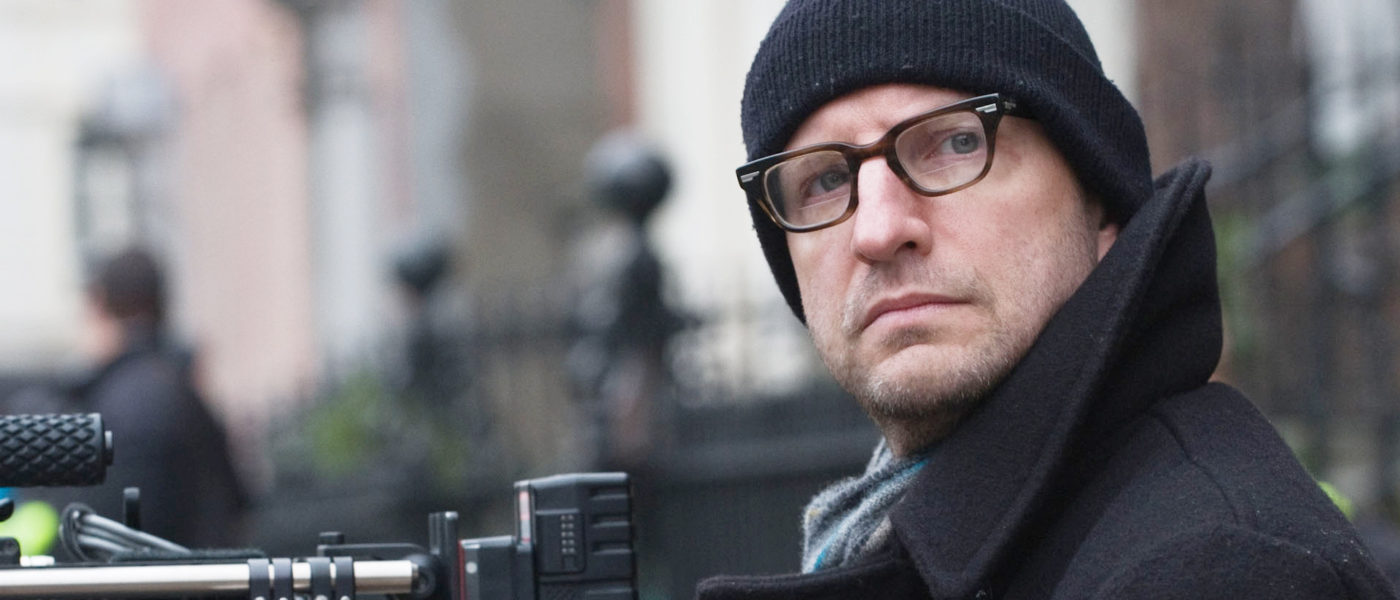The Many Faces of America’s Blatantly Diverse Filmmaker
 One July morning in 1989, I woke up in my New York apartment to find my roommate Gary chatting excitedly on the phone. Seeing I was up, he called out to me. “Hey, Dean, guess who I’m talking to? It’s Pauline Kael!”
One July morning in 1989, I woke up in my New York apartment to find my roommate Gary chatting excitedly on the phone. Seeing I was up, he called out to me. “Hey, Dean, guess who I’m talking to? It’s Pauline Kael!”
I was, of course, astonished he was gabbing away with the famed New Yorker critic—I didn’t yet know it was a regular thing for her to contact people who’d written to her, as Gary had after reading her enthusiastic ravings over Tim Burton’s Batman, a movie I loved at first and then vehemently hated upon my second helping. “She agrees it’s the best movie of the year,” Gary said and, with this, I groaned. He laughed and told her how much I disliked the superhero film. “She wants to know what you think the best movie of the year is!” Spike Lee’s Do The Right Thing wouldn’t be out for another month, so I answered “So far, it’s sex, lies and videotape.” He relayed this to her, and yelled back “She says it’s garbage, and that you’re wrong!” I was a bit crestfallen for about 10 seconds—this would be as close as I would come to talking to Ms. Kael, and already I’d made her an adversary. Then I remembered how superb Steven Soderbergh’s debut film assuredly is, and I shrugged. “Ahh, she’s fulla beans half the time anyway,” I told myself.
(Soderbergh has) delivered an astonishingly wide-ranging slate of movies, and the majority of them have been resolutely successful, if not at the box office, then certainly in cumulative effect. He’s kind of a miracle worker.
Bless her departed soul, she’s still wrong about Soderbergh. He’s emerged since then to become Hollywood’s (if not the world’s) most blatantly diverse filmmaker. In the 28 years since his Palme D’Or-winning debut–he’s still the youngest director to ever win that award at Cannes, at 26–he’s delivered an impressively wide-ranging slate of movies, and the majority of them have been resolutely successful, if not at the box office, then certainly in cumulative effect. He’s kind of a miracle worker.
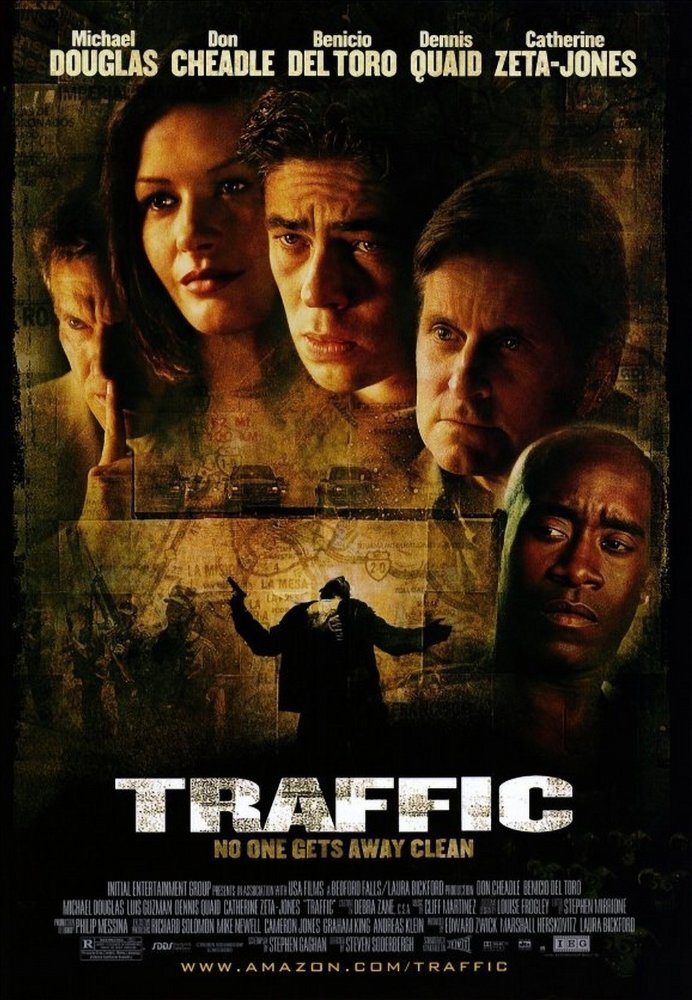 There are only a couple of his pieces I’m not enthusiastic about at all – his sophomore feature Kafka (stunning visuals in service of a dull story) and his leaden black-and-white period piece The Good German. And then there are his many other films, and all of them work gloriously. Of course, among them, the first one I recall is Traffic, his thrilling remake of a British TV drama profiling the murderous levels of the drug trade, transplanted to America and given a vibrant rejiggering that won Soderbergh the Best Director Oscar (that year, he entered the record books as being the first filmmaker since Michael Curtiz in 1938 to garner two nominations for that award in one year, the other being his crowd-pleasing character study Erin Brokovich, which led Julia Roberts to her own Oscar glory).
There are only a couple of his pieces I’m not enthusiastic about at all – his sophomore feature Kafka (stunning visuals in service of a dull story) and his leaden black-and-white period piece The Good German. And then there are his many other films, and all of them work gloriously. Of course, among them, the first one I recall is Traffic, his thrilling remake of a British TV drama profiling the murderous levels of the drug trade, transplanted to America and given a vibrant rejiggering that won Soderbergh the Best Director Oscar (that year, he entered the record books as being the first filmmaker since Michael Curtiz in 1938 to garner two nominations for that award in one year, the other being his crowd-pleasing character study Erin Brokovich, which led Julia Roberts to her own Oscar glory).
But I also have an intense love for his smaller films—the hallucinogenic Scientology spoof Schizopolis (where Soderbergh hilariously plays the lead); Bubble, the tense workplace comedy with an all-amateur cast; Gray’s Anatomy, his electrifying collaboration with the late monologist Spalding Gray; The Girlfriend Experience, an incisive look at the day in the life of a call girl, played by porn star Sasha Grey; and Magic Mike, his exuberant comedy set in the world of male strippers that became probably his most profitable hit.
Soderbergh has enriched the crime genre with some of his most spectacular work: The Limey, his ace L.A. saga headed by a brutal Terrence Stamp; the Ocean’s Eleven movies, both of which are pure odes to Big Hollywood and the heist yarn; his crackling, brilliantly scripted (by Scott Burns) Elmore Leonard adaptation Out of Sight; his Hitchcockian murder tale-cum-Big Pharma takedown Side Effects; The Underneath, an entertaining 1990 reworking of the classic noir heist film Criss Cross; and The Informant!, a criminally underrated dissection of corporate malfeasance driven by a perfectly goofy Matt Damon.
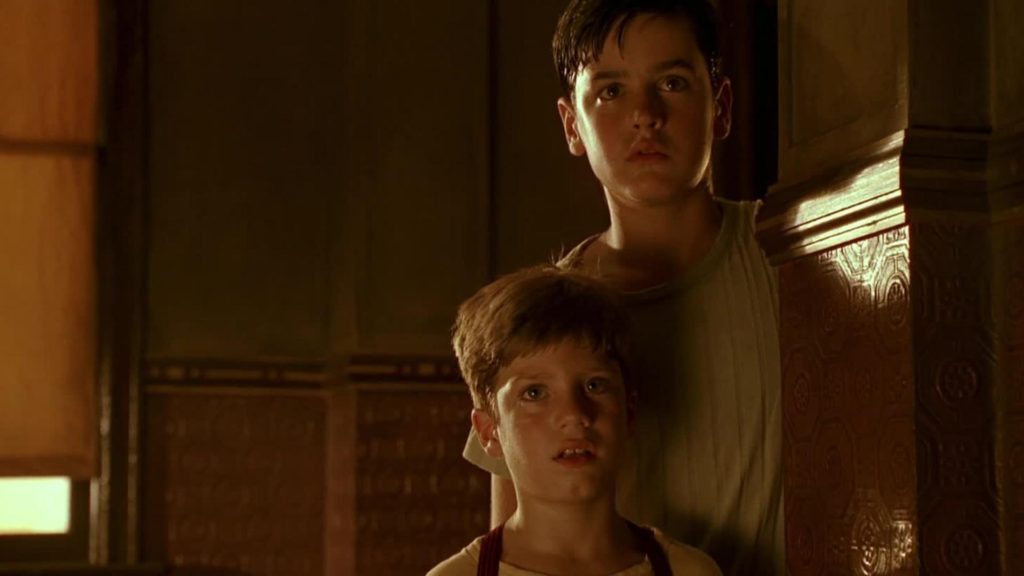
The St. Louis-based KING OF THE HILL, 1993.
But he’s also attacked sci-fi (in Solaris, his effective remake of Tarkovsky’s landmark film—a brave thing to even attempt to do); the bio-pic (in his two-part epic Che, with Benicio Del Toro as the Cuban revolutionary, and in Behind the Candelabra, an HBO movie with Michael Douglas excelling as campy piano master Liberace); the spy film (Haywire, the dazzling actioner with female Mixed Martial Arts champ Gina Carano dispatching Michael Fassbender in arguably the best fight scene ever committed to film); the horror film (his bleak, world-hopping look at a killer viral pandemic in Contagion); the family drama (King of the Hill, perhaps my favorite of Soderbergh’s works, with Jesse Bradford as the writer A.E. Hochner, in a harrowing but resolutely uplifting account of a tough Depression-era childhood); and even television (his most recent show The Knick, about the medical practice at the turn of the 20th Century, isn’t even his first—that spot belongs to K Street, his ridiculously authentic examination of Washington lobbyists led by the royalty of that world, James Carville and Mary Matalin).
To add to all this, Soderbergh’s proven to be tops as a screenwriter, a producer, an editor and a cinematographer (since Traffic, he’s served as his own photographer, working under the name Peter Andrews). It’s impossible not to be bowled over by his achievements. Even so, in frustration over how increasingly difficult it is to produce the kinds of films he loves to make, he’s threatened to retire from the big screen, but I knew this couldn’t hold: he’s got three works in development for the coming years. You just can’t squelch an over-flowingly courageous talent the likes of Steven Soderbergh.
Here’s a rundown of the Soderbergh movies our critics at ZekeFilm are just now getting around to watching for the first time:
– Dean Treadway
Full Frontal
(2002/Miramax/ dir. Steven Soderbergh)
by Robert Hornak
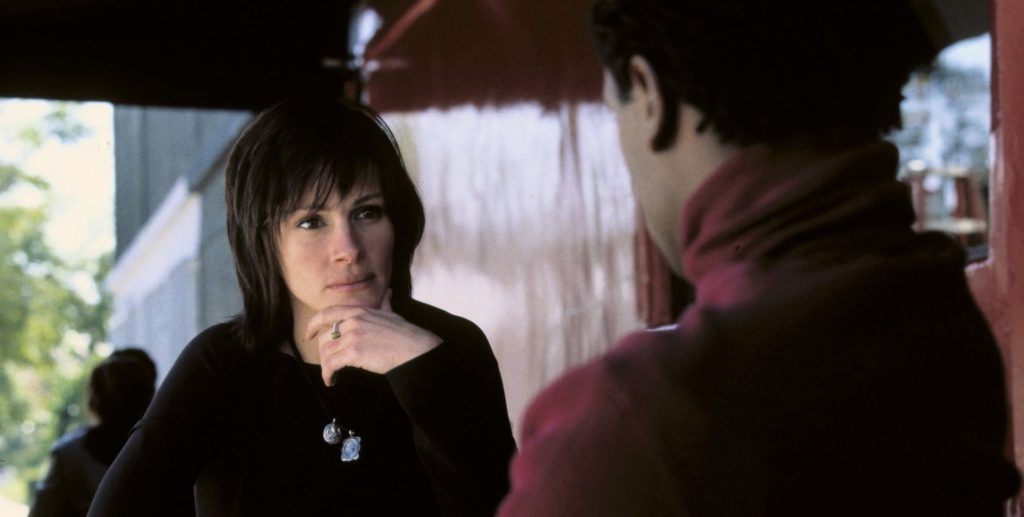
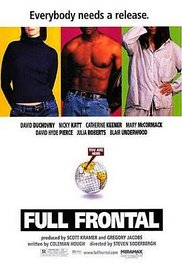 Soderbergh’s IMDb page looks like five directors’ lists shuffled into one, so dispersed in subject, tone, and style that you wonder if he’ll end up ranked as one of those journeyman directors whose body of work is impossible to box up neatly. It’s the impression of an artist trying to find himself – except that there’s a kind of consistency in the force of intelligence – even in the gaudier “Hollywood” fare – that makes it all of a piece. Any given movie feels so competent and sure, you can’t help but think he’s always making the movie he wants to make, and how he wants to make it.
Soderbergh’s IMDb page looks like five directors’ lists shuffled into one, so dispersed in subject, tone, and style that you wonder if he’ll end up ranked as one of those journeyman directors whose body of work is impossible to box up neatly. It’s the impression of an artist trying to find himself – except that there’s a kind of consistency in the force of intelligence – even in the gaudier “Hollywood” fare – that makes it all of a piece. Any given movie feels so competent and sure, you can’t help but think he’s always making the movie he wants to make, and how he wants to make it.
The proof of consistency is most evidenced when he makes two radically different movies back to back, like The Limey and Erin Brockovich, or Ocean’s 11 and my Film Admission, Full Frontal – though it’s not much of an admission since I wonder if anyone actually saw it. It’s a dryly bitter comedy about all the ways Los Angeles infects behavior, how the swirling fakeness of entertainment goals, the shallowness of the only people who can make those goals a reality, and the eventual hollowness of the final product all invade every interaction, decision, facial expression. Its surface is one of those you-are-there, jump-cutty exercises that were in vogue in the wake of the ’90s independent boom with the crucial difference that it’s the product of someone who’s gone big-budget and knows his target. His experience with the $100-million purse provides the clout necessary to skewer, and he does it as smilingly as Brutus on the ides.
It almost feels like Soderbergh’s dirty little secret (is) that he’s corralled a couple of the biggest names in Hollywood to make fun of Hollywood…
The washed-out, vérité scenes were shot with a consumer digital video camera, and they’re meant to express the “real life” of a host of Hollywood worker bees, while the slick, locked-down 35mm scenes show us the movie that a few of the characters star in (mostly Julia Roberts and Blair Underwood), though we don’t see them in any real life segments until well after we’re involved in their movie-within-the-movie. By that point, we’ve already been swimming in the anxiety of the other characters, a specific kind of angst born of creative pressure endemic to L.A., so that soon we feel the essence of the city’s particularly sunny brand of psychic destruction, the way life drifts into fantasy, how the tail wags the dog, how the mind can slip ever so gently off the pan until there is no line left between a movie and the lives of the people making it. It’s a morbidly fun, Mobius strip of a movie-movie that was shot mostly guerrilla style, yet maintains the borrowed sheen of that which it mocks, thanks almost single-handedly to Roberts, whose star power makes up for ten other actors, with frat-clouded Brad Pitt thrown in for good measure. It almost feels like Soderbergh’s dirty little secret that he’s corralled a couple of the biggest names in Hollywood to make fun of Hollywood, except that it also feels like, for them, a reverse vanity project to show off how willing they are to strip their image and craft down to nothing – maybe the “full frontal” exposure of the teasing title. The movie’s subversion is that the back-and-forth from high-gloss movie to cold and harsh real life is clever enough, you actually start to feel sorry for the rich, famous, and self-indulgent.
The Limey
(1999/Artisan Entertainment/dir. Steven Soderbergh)
by Sharon Autenrieth
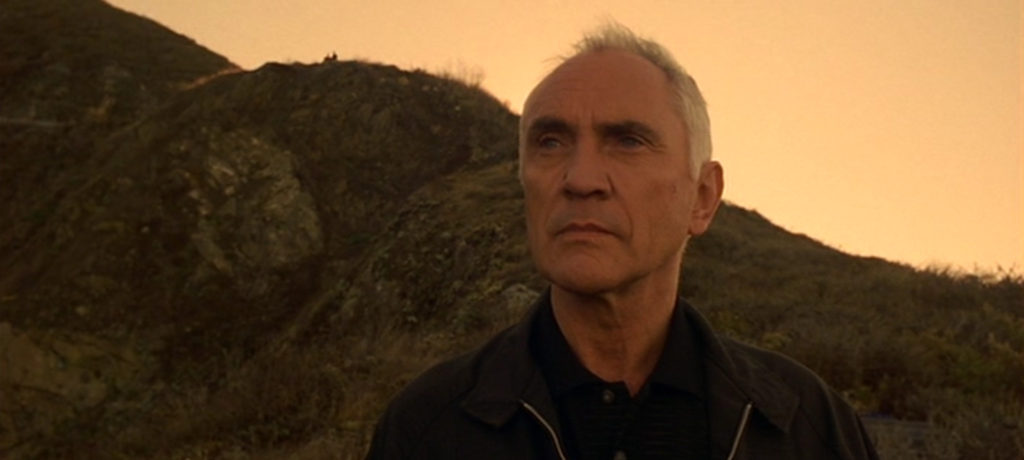
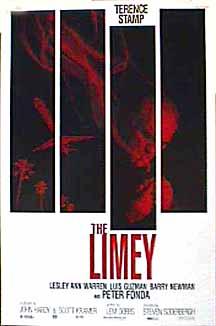 The Limey is a revenge drama in dreamscape. Fantasies, fast forwards, and flashbacks blend, paradoxically, with a very straightforward narrative. A strange, quiet man comes to town to avenge his daughter’s death, does so, and then goes home again. That’s it, in its most stripped down form, but it’s loaded with so much beauty, loss, and sharp eyed commentary on L.A.’s entertainment culture that to simply describe it as a revenge film seems all wrong.
The Limey is a revenge drama in dreamscape. Fantasies, fast forwards, and flashbacks blend, paradoxically, with a very straightforward narrative. A strange, quiet man comes to town to avenge his daughter’s death, does so, and then goes home again. That’s it, in its most stripped down form, but it’s loaded with so much beauty, loss, and sharp eyed commentary on L.A.’s entertainment culture that to simply describe it as a revenge film seems all wrong.
Terence Stamp plays Wilson, a British ex-con whose daughter, Jenny, went to Hollywood to become an actress and wound up, instead, as the girlfriend of a record producer – before she wound up dead. Wilson doesn’t accept the explanation that his daughter died in an accident, and it’s not long before he’s pegged the boyfriend, Valentine (Peter Fonda) as the responsible party.
Fonda is both oily and skeletal. When he pulls back his lips from that famous smile he looks like a predator ready to strike. But while he’s without a conscience, he is not a particularly menacing villain. He’s accustomed to the ministrations of younger women – with Jenny gone, he’s turned to a lookalike (Adhara, played by Amelia Heinle), and to having his dirty work done by a squadron of goons under the direction of his right hand man, Avery (Barry Newman).
The Limey is a revenge drama in dreamscape. Fantasies, fast forwards, and flashbacks blend, paradoxically, with a very straightforward narrative.
It’s dead clever, bringing together the trio of aging men that director Steven Soderbergh used in The Limey. Fonda, of course, was the star of the ‘60s cult classic Easy Rider (and there are nods to this film in Valentine’s story of a motorcycle accident and his pining for the ’60s). Barry Newman was the star of another vehicular classic, 1971’s Vanishing Point, and he’s given the one car chase that The Limey has to offer. As for Stamp, he was a veteran of British film by the end of the ’60s. For flashbacks of Wilson’s life, Soderbergh brilliantly uses scenes from Ken Loach’s 1967 film Poor Cow, in which Stamp played a thief named Wilson who also had a daughter. Each man seem like a version of his younger character gone to seed, making the film a subtle comment on the loss of the ’60s energy and promise.
In contrast to the craven Valentine, Stamp’s Wilson is as self-contained as a statue. He is handsome in a worn down way; cool, impassable. That’s the external view, at least. His interior landscape is what fills the movie with both memories and his vision for what he must do. His quest for his daughter’s killer seems driven less by rage than by a need to close the chapter on his failures as a father. He may not be able to mend the past, but he will do his daughter the final service of making her killer pay. It feels inevitable, but the inevitability doesn’t diminish The Limey’s power. It’s a meditation on regret that moves inexorably to the confrontation between the father and the lover who each betrayed Jenny in different ways. Jenny tried to save both men and failed each time. In the case of Valentine, it cost her her life.
The Limey is a potent little movie. In Soderbergh’s prolific career it is sandwiched between Out of Sight and Traffic. Traffic would echo some of the themes of a regret and loss between a father and his child. But the psychological drama of The Limey is closer to another Soderbergh movie, 2002’s Solaris. The real question, unanswered at the end of The Limey, is whether revenge will set Wilson free from his guilt, or whether his life will continue to be haunted by the daughter who could not save him.
Out of Sight
(1998/Universal Pictures/dir. Steven Soderbergh)
by Taylor Blake
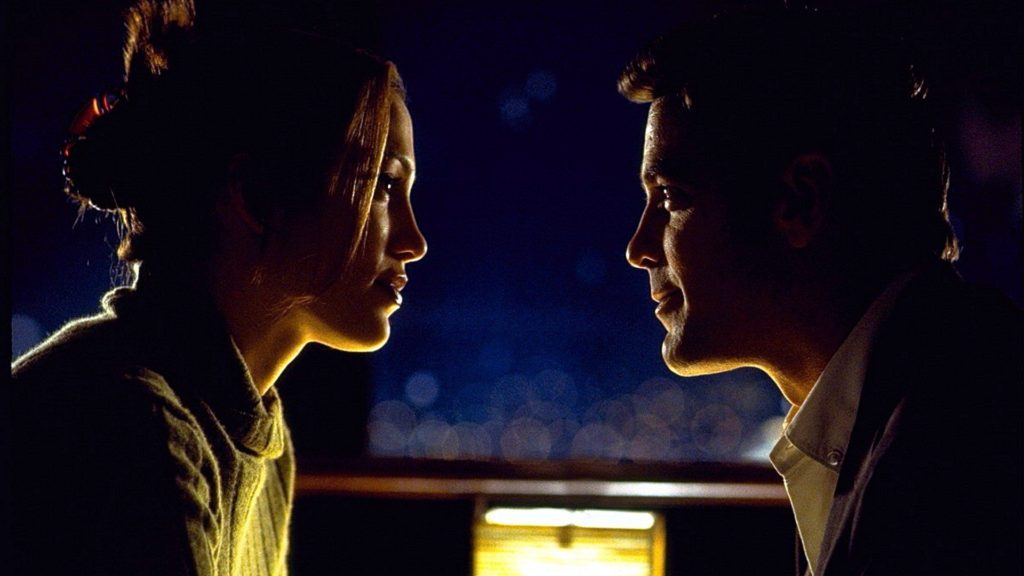
 Smooth. Suave. Sexy. That’s Soderbergh.
Smooth. Suave. Sexy. That’s Soderbergh.
And what leading man could be a better match for smooth, suave, and sexy than George Clooney? You might know of their oft-repeated partnership because of the Ocean’s Eleven franchise, but it began with 1998’s Out of Sight.
Clooney plays career bank robber Jack Foley, whose charm means he’s never needed a gun. Jennifer Lopez is Karen Sisco, the no-nonsense federal officer hunting him down. But fate seems to be telling them their paths are meant to cross in more than just a cops-and-robbers chase. Both are immediately intrigued by the other smooth, suave, and sexy individual on the other side of the law, and despite their practical judgment, keep crossing those lines to find each other again.
It’s just as fun as you’d expect from a Soderbergh/Clooney feature, and yes—just as smooth, suave, and sexy as you’d expect, too.
If you told me Out of Sight was the secret prequel for Ocean’s Eleven, I’d have to believe you. Except for a few inconsequential details like Clooney’s character name and the striking resemblance of burglar Maurice Miller to burglar Basher Tarr (Don Cheadle in both roles), I’d buy it. And if you too can accept that Jack Foley/Danny Ocean’s connection to Karen wasn’t strong enough to last forever (I’ll bet you can), then it would make all the sense in the world that we’d find him stealing from the Bellagio and wooing Julia Roberts’s Tess Ocean back just a few years later.
Out of Sight doesn’t reach the same level of energy and wit—it’s the slow swing opener to Ocean’s jazzy main act. Its plot isn’t nearly as complicated, but it still has enough few tricks up its sleeve. But it’s just as fun as you’d expect from a Soderbergh/Clooney feature, and yes—just as smooth, suave, and sexy as you’d expect, too.
sex, lies and videotape
(1989/Outlaw Productions/dir. Steven Soderbergh)
by Jim Tudor

 1989 was a big year for this movie movie fan. I was turning sixteen, and looking forward to new installments of Indiana Jones, Star Trek and Ghostbusters, not to mention the inescapable behemoth of them all, Tim Burton’s Batman. Yes sir, 1989 would be a game-changer at the movies. With my multiplex blinders gleefully in place for what would be a warmed-over rehash of the summer of 1984, but with Batman, little did I realize how true that notion, in fact, was. Spike Lee’s 1989 Do the Right Thing remains a preeminent look at American racial strife, and Steven Soderbergh’s sex, lies and videotape, that same year, opened the door to other such scrappy, grown-up indies. The chatter about sex, lies was inescapable – much to the uncomfortable chagrin of this straight-arrow youth. Whereas most other boys my age would’ve been plotting to get a look at a movie with so much provocation in the title, sex, lies‘ air of edgy, rooted sophistication simply sounded over my head. So intimidated was I that this seminal film remained unwatched even through a strong phase of Soderbergh film fascination, spanning from Out of Sight through Ocean’s Eleven.
1989 was a big year for this movie movie fan. I was turning sixteen, and looking forward to new installments of Indiana Jones, Star Trek and Ghostbusters, not to mention the inescapable behemoth of them all, Tim Burton’s Batman. Yes sir, 1989 would be a game-changer at the movies. With my multiplex blinders gleefully in place for what would be a warmed-over rehash of the summer of 1984, but with Batman, little did I realize how true that notion, in fact, was. Spike Lee’s 1989 Do the Right Thing remains a preeminent look at American racial strife, and Steven Soderbergh’s sex, lies and videotape, that same year, opened the door to other such scrappy, grown-up indies. The chatter about sex, lies was inescapable – much to the uncomfortable chagrin of this straight-arrow youth. Whereas most other boys my age would’ve been plotting to get a look at a movie with so much provocation in the title, sex, lies‘ air of edgy, rooted sophistication simply sounded over my head. So intimidated was I that this seminal film remained unwatched even through a strong phase of Soderbergh film fascination, spanning from Out of Sight through Ocean’s Eleven.
James Spader plays a weirdly sympathetic heartbroken guy who’s only viable route to sexual fulfillment is through videotaped erotic testimonies by women he meets.
Finally, the time has come. And I’m here to say that sex, lies and videotape is worth its reputation, remaining to this day more relevant than the last third of its own title (videotape – who remembers what that is?), if not most films. (Sex and lies, however, for better and worse, respectively, will never go out of style.) It’s just as good as they say. James Spader plays a weirdly sympathetic heartbroken guy who’s only viable route to sexual fulfillment is through videotaped erotic testimonies by women he meets. He films them, but has no physical intimacy with them. Spader creates these private tapes for himself, and based on his collection, has little trouble courting subjects. Though ever Spader-esque, he is clearly not the perverted deviant he is accused of being.
The true protagonist, a traditional and buttoned-up housewife character played by Andie MacDowell, becomes fascinated with Spader, particularly once her cheating husband’s ways become clear to her. The way this is played in the story is proof positive of the “forward thinking” perception grafted onto the film in its heyday. But despite the title and disproportionate amount of frank talk and a particular open-mindedness, no sex, or even nudity is shown. There’s plenty of videotape, and no shortage of lies. But depicted sex, no. And dare I say, this holding back on such an expected exploitative element in favor of a humanist, dialogue-driven approach is what actually makes it groundbreaking. We also have Peter Gallagher and Laura San Giacomo as MacDowell’s husband and sister, respectively, carrying on a secret affair. It is this considerably more traditional perversion of human intimacy that is outed as truly twisted. All four characters are unforgettably written (by Soderbergh) and acted, as the film itself clips along, always engagingly. It’s one little career-maker well worth the 1989 rewind.
[youtube https://www.youtube.com/watch?v=JK5slvV7Lbw]
“I think this world would be unlivable without art.” – Steven Soderbergh, in his great Oscar acceptance speech for Best Director (TRAFFIC, 2000).


